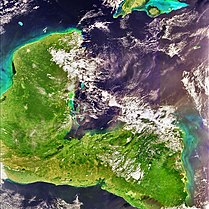
Back Grupos étnicos de América Central Spanish Groupes ethniques d'Amérique centrale French Етнічні групи Центральної Америки Ukrainian

| Part of a series on |
| Central America |
|---|
 |
Central America is a subregion of the Americas[1] formed by six Latin American countries and one (officially) Anglo-American country, Belize. As an isthmus it connects South America with the remainder of mainland North America, and comprises the following countries (from north to south): Belize, Guatemala, Honduras, El Salvador, Nicaragua, Costa Rica, and Panama.
The inhabitants of Central America represent a variety of ancestries, ethnic groups, and races, making the region one of the most diverse in the world. Some of the countries have a predominance of mixed Amerindian–European, or mestizo, population, while others are inhabited by those of European or Black African ancestry. Asian and mixed race Afro-Amerindian minorities are also identified regularly. People with mestizo ancestry are the largest single group, and along with people of greater European ancestry, comprise approximately 80% of the population,[2] or even more.[3]
In 2007, Central America had a population of approximately 40 million persons within an area of 523,780 km2, yielding an overall density of 77.3 inhabitants/km2 that is not distributed evenly. For example, Belize is larger than El Salvador in area by 1,924 km2, but El Salvador has 30 times the population of Belize. Similarly, the population of Costa Rica is greater than that of Panama, while Panama is greater in area. Guatemala has the largest population with 13.2 million, followed by Honduras at 7.8 million.
- ^ "Central America". central-america.org. Retrieved 4 September 2016.
Central America is located between North and South America and consists of multiple countries. Central America is not a continent but a subcontinent since it lies within the continent America. It borders on the northwest to the Pacific Ocean and in the northeast to the Caribbean Sea. The countries that belong to the subcontinent of Central America are El Salvador, Costa Rica, Belize, Guatemala, Honduras, Nicaragua, Mexico and Panama.
- ^ "CIA — The World Factbook – Field Listing — Ethnic groups". Archived from the original on 2019-01-06. Retrieved 2008-02-20.
- ^ Lizcano Fernández, Francisco (May–August 2005). "Composición Étnica de las Tres Áreas Culturales del Continente Americano al Comienzo del Siglo XXI" (PDF). Convergencia (in Spanish). 38. Mexico: Universidad Autónoma del Estado de México, Centro de Investigación en Ciencias Sociales y Humanidades: 185–232, table on p. 218. ISSN 1405-1435. Archived from the original (PDF) on September 20, 2008.
© MMXXIII Rich X Search. We shall prevail. All rights reserved. Rich X Search